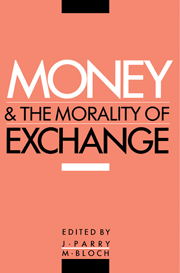Book contents
- Frontmatter
- Contents
- List of contributors
- 1 Introduction: Money and the morality of exchange
- 2 Misconceiving the grain heap: a critique of the concept of the Indian jajmani system
- 3 On the moral perils of exchange
- 4 Money, men and women
- 5 Cooking money: gender and the symbolic transformation of means of exchange in a Malay fishing community
- 6 Drinking cash: the purification of money through ceremonial exchange in Fiji
- 7 The symbolism of money in Imerina
- 8 Resistance to the present by the past: mediums and money in Zimbabwe
- 9 Precious metals in the Andean moral economy
- 10 The earth and the state: the sources and meanings of money in Northern Potosí, Bolivia
- Index
9 - Precious metals in the Andean moral economy
Published online by Cambridge University Press: 20 February 2010
- Frontmatter
- Contents
- List of contributors
- 1 Introduction: Money and the morality of exchange
- 2 Misconceiving the grain heap: a critique of the concept of the Indian jajmani system
- 3 On the moral perils of exchange
- 4 Money, men and women
- 5 Cooking money: gender and the symbolic transformation of means of exchange in a Malay fishing community
- 6 Drinking cash: the purification of money through ceremonial exchange in Fiji
- 7 The symbolism of money in Imerina
- 8 Resistance to the present by the past: mediums and money in Zimbabwe
- 9 Precious metals in the Andean moral economy
- 10 The earth and the state: the sources and meanings of money in Northern Potosí, Bolivia
- Index
Summary
Of the rich variety of resources which the diversified ecology of the Andes has yielded to its human inhabitants down the centuries, precious metals have for long been the most highly prized. In pre-Inka and Inka times gold and silver, fashioned into exquisite ornaments, woven into cloth and encasing entire buildings, gilded and encoded the power of local chiefs, ethnic lords and state elites. The conquistadors' lust for gold and silver, in its turn, fired the Spanish conquest of the Inka empire. In the colonial era the mining of Andean precious metals, chiefly silver, was the armature around which the entire Spanish imperial economy revolved. Thanks to a common cultural fixation in both the Old World and the New on gold and silver as the supreme forms of value, the gift-symbols of political power in native Andean society were transmuted after the Spanish conquest into the global commodity-currencies of mercantile capitalism.
Today, gold and silver no longer perform such prominent political or economic functions in Andean society. Since the late nineteenth century, industrial mining in the region has been directed primarily at the extraction of base metals, chiefly tin, lead, iron, zinc and copper. Precious metals are still mined on a small scale, however, not just industrially but also by individuals, for whom gold promises a rapid route to riches. But for many of these private prospectors, gold is by no means an unencumbered commodity.
- Type
- Chapter
- Information
- Money and the Morality of Exchange , pp. 209 - 231Publisher: Cambridge University PressPrint publication year: 1989
- 16
- Cited by



